New Delhi: The Railways recorded its worst-ever operating ratio (OR) of 107.39 per cent — which means it spent Rs 107.39 to earn Rs 100 — in 2021-22, the Comptroller and Auditor General (CAG) has said in a report tabled in Parliament.
Tabled Tuesday, it also flagged a huge backlog in renewal and replacement of ‘over aged assets’ critical for safe running of trains.
The national auditor added that even the all-time high OR of 107.39 per cent in 2021-22 does not reflect the true financial performance of the Railways. If the actual expenditure on pension payments as well as expenditure on the Depreciation Reserve Fund (DRF) — which is maintained for replacement and renewal of old assets — was taken into account, the OR would have been higher, at 109.36 per cent.
“Against the target of 96.15 per cent in the Budget Estimates, the Operating Ratio of Railways was 107.39 per cent in 2021-22. As compared to the Operating Ratio of 97.45 per cent during 2020-21, there was deterioration in 2021-22…A higher ratio indicates poorer ability to generate surplus,” said the report, which examined finance accounts of Indian Railways for the year ended 31 March, 2022.
India has 17 Zonal Railways. As per CAG’s audit analysis, the OR of six of these — East Coast, North Central, South Central, South Eastern, South East Central and West Central Railways — was below 100 per cent, with that of East Coast being the best at 54.58 per cent.
However, the remaining 11 Zonal Railways — Central, Eastern, East Central, Northern, North Eastern, Northeast Frontier, North Western, Southern, South Western, Western and Metro Railway/Kolkata — recorded an OR of more than 100 per cent during 2021-22, with that of Metro Railway/Kolkata being the worst at 432.19 per cent.
“This implies that the working expenditure of these Railways was more than their traffic earnings,” the report said.
Tabling a grim picture of Railways Finances, the CAG recommended that Indian Railways needs to critically analyse the cost of passenger operations and take steps to reduce its losses, and also augment internal revenues.
It added that the national transporter needs to take steps to diversify their freight basket to enhance freight earnings. Currently, transportation of coal constitutes about 46 per cent of its freight earnings.
While the budget allocation for Railways‘ capital expenditure has been on the rise in recent years, the financial performance of Railways has shown a decline in the “excess of earning over expenditure”, or surplus, in the six years from 2016-17 to 2021-22.
For the current fiscal year, 2023-24, the central government has allotted the highest-ever outlay of Rs 2.40 lakh crore for Indian Railways’ capital expenditure. During her Budget speech, Finance Minister Nirmala Sitharaman pointed out that this was over nine times the amount earmarked in financial year 2013-14.
Huge backlog
It also flagged that there is a huge backlog of renewal and replacement of over-aged assets, which needs to be replaced timely, for safe running of trains. The CAG noted that during 2021-22, Rs 200 crore was appropriated to the DRF against the Budget Estimate (BE) of Rs 1,000 crore and Rs 661.02 crore spent from the fund for Zonal Railways and production units.
“The amount is insignificant compared to the actual amount required for the renewal and replacement of over-aged assets. The fund balance at the end of 2021-22 is Rs 136.22 crore. The ‘throw forward’ value of assets (brought forward from previous year) to be replaced from DRF (up to 2021-22) was estimated at Rs 34,318.79 crore,” it said, adding that this mainly included Rs 3,541.92 crore on track renewals, Rs 23,762.73 crore on rolling stock, Rs 1,077.33 crore on bridge works, tunnel works and approaches, Rs 1,464.86 crore on signaling and telecommunication works, Rs 1,683.08 crore on staff welfare and Rs 2,763.06 crore on workshops, including production units.
“The provision made to the fund for replacement and renewal of assets is inadequate. This has steadily decreased in the past five years and was insufficient to meet the requirements. There is every possibility and especially in the background of depleting surplus, that replacement and renewal of over-aged assets could become a burden for the Government of India,” the CAG said.
The CAG pointed out that against the BE of Rs 6,561 crore, the ‘Net deficit’ after meeting all revenue liabilities was Rs 15,024.58 crore in 2021-22 as compared to net surplus of Rs 2,547.48 crore in 2020-21. “The Railways would have ended up with more negative balance of Rs 18,240.52 crore (instead of Rs 15,024.58 crore), if the actual amount (Rs 51,215.94 crore) required to meet the expenditure on pension payments of the Railways had been appropriated to the Pension Fund,” it said.
(Edited by Smriti Sinha)
Also read: House panel cautions Modi govt on proposed common voter list — ‘avoid stepping into states’ domain’






